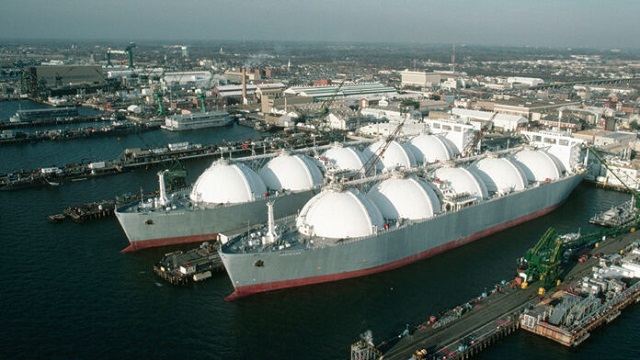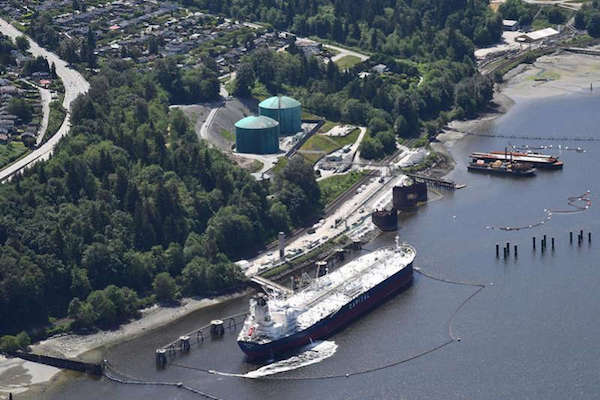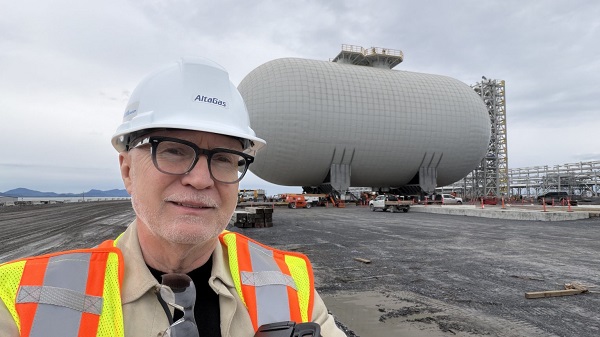Energy
Texas Legislative Committee Proposes Ways to Protect, Expand LNG Industry

From Heartland Daily News
By Bethany Blankley
“the Biden Administration’s federal permitting pause during a presidential election year appears to be purely political in nature and an attempt to disrupt Texas’ booming economy, now the eighth largest economy in the world…. it is abundantly clear American LNG is in the best interest of the Texas economy, local communities, our national security, and global energy security.”
A state legislative committee is proposing ways to expand Texas’ liquified natural gas (LNG) industry after the Biden administration announced it was pausing pending applications for LNG exports that would significantly impact Texas.
The Texas House Select Committee on Protecting Texas LNG Exports issued its findings after holding a hearing on the topic earlier this month. Led by state Rep. Jared Patterson, R-Frisco, the report states, “the Biden Administration’s federal permitting pause during a presidential election year appears to be purely political in nature and an attempt to disrupt Texas’ booming economy, now the eighth largest economy in the world.
“It has caused long-term uncertainty for both investors and allied nations around the world relying on American energy, particularly in Europe as they seek to wean themselves off Russian natural gas. After multiple studies across Democratic and Republican presidential administrations, it is abundantly clear American LNG is in the best interest of the Texas economy, local communities, our national security, and global energy security.”
House Speaker Dade Phelan, R-Beaumont, created the select committee and charged it with evaluating the impact on the Texas LNG industry and to propose actions the state legislature could take in the next legislative session to protect it.
Phelan’s district is critical to the oil and natural gas industry. It encompasses a region known as the “Golden Triangle,” rich in oil and natural gas production, processing, refining and exports in the southeast towns of Beaumont, Port Arthur and Orange. It includes a key LNG export terminal currently under construction in Port Arthur, where several LNG facilities are also located.
The LNG terminal, once completed and operational, is expected to have an export capacity of 13 million tons a year. With access to the Gulf of Mexico through the Sabine-Neches ship channel, it represents a $13 billion investment in new energy infrastructure, the report states.
The U.S. leads the world in LNG exports, led by the Gulf states of Texas and Louisiana. In 2017, the U.S. became a net exporter of natural gas for the first time since 1957, “primarily because of increased LNG exports,” according to the EIA. The U.S. became a net exporter after Cheniere Energy was the first to export domestically sourced LNG from the Sabine Pass LNG Terminal in Cameron Parish, Louisiana, and from the Port of Corpus Christi in Texas, The Center Square first reported.
Nearly 25% of U.S. natural gas reserves are located in Texas and 30% of the largest hundred natural gas fields in the U.S. are in Texas, the legislative report notes, citing state data. It also identifies six LNG facilities nationwide that would be impacted by the ban, including two in Texas, in Port Arthur and Corpus Christi.
Texas ports, including Port Arthur and Corpus Christi, are among the top ports in the U.S. leading in foreign trade impact, and the Port of Corpus Christi continues to break records in tonnage, primarily due to oil and LNG exports, The Center Square reported.
Texas Oil & Gas Association Chief Economist Dean Foreman, who testified before the committee, said, “Texas and Louisiana bear the brunt of short-sighted federal policies that jeopardize LNG export projects, representing potential investments of $200 billion across the value chain, including a projected 20% increase in Texas’ dry natural gas production.
“The reasons given for this pause – concerns about higher domestic natural gas prices, emissions, and community impacts – are clearly unfounded. U.S. LNG exports have responded to global demand, driving domestic innovation that enhances productivity and reduces consumer costs. LNG has replaced coal in power generation, emerging as a primary driver of emission reductions, and have catalyzed economic growth across the Gulf Coast. On all accounts, U.S. LNG exports have proven to be decisively beneficial.”
Two key claims the administration made for implementing the ban (LNG exports increase domestic energy costs and increase methane emissions) have been refuted, The Center Square first reported. A bipartisan coalition of Texas’ congressional delegation called on the president “to refocus on policies that support US LNG,” understanding that Texas is the energy capital of the United States, The Center Square reported. Sixteen states, led by Louisiana and Texas, also sued, arguing the ban is illegal.
The committee recommended that the legislature “consider legislation and policies authorizing the governor to develop and execute an interstate compact with the goal of sharing state information, resources, and services with other interested states seeking to protect and grow the LNG industry along the Gulf Coast.”
It also recommends that the legislature propose legislation and policies to permit temporary eligibility of LNG facility construction grants and loans when federal permitting pauses occur; provide economic incentives for LNG facilities to counter market consequences of a federal permitting pause; reform specific permitting regulations and increase overall permitting process efficiency; expand funding for project construction and development through the Texas Department of Transportation’s Maritime Infrastructure Program; increase workforce grants made available through local colleges to meet workforce demands for construction and facility operations; and mandate that official reports be published every year providing data on the “relevance and importance of the LNG industry regarding the public interest.”
Bethany Blankley is a contributor at The Center Square.
Originally published by The Center Square. Republished with permission.
Energy
Tanker ban politics leading to a reckoning for B.C.

From Resource Works
That a new oil pipeline from Alberta to BC is being aired by Ottawa and pushed by Alberta has, in turn, critics eagerly pushing carefully crafted scare stories.
Take the Green Party’s Elizabeth May, for one: She insists that oil tankers leaving Prince Rupert would be sailing through “Canada’s most dangerous waters and the fourth most dangerous waters in the world.”
First, this “dangerous waters” claim is unsubstantiated, unproven, and hyperbolic. It is apparently based on a line in a 1992 federal guide to marine-weather hazards on the west coast, but it is not credited or supported there.
Second, who says a new oil pipeline would go to Prince Rupert? No destination is specified in the memorandum of understanding published by Ottawa and Alberta.
It speaks of a commitment to “enable the export of bitumen from a strategic deep-water port to Asian markets.”
Energy Minister Tim Hodgson: “There is no route today. Under the MoU, what (Alberta) would need to do is work with the affected jurisdiction, British Columbia, and work with affected First Nations for that project to move forward. That’s what the work plan in the MoU calls for.”
First Nations concerned
Now, the MoU does say that this could include “if necessary” a change to the federal ban on oil tankers in northwest BC waters.
Some First Nations are strongly fighting the idea of oil tankers in northern BC waters citing fears of a catastrophic spill. The Assembly of First Nations (AFN), for example, is calling for the Canada-Alberta pipeline MoU to be scrapped.
“A pipeline to B.C.’s coast is nothing but a pipe dream,” said Chief Donald Edgars of Old Massett Village Council in Haida Gwaii.
And AFN National Chief Cindy Woodhouse Nepinak said: “Canada can create all the MOUs, project offices, advisory groups that they want: the chiefs are united. . . When it comes to approving large national projects on First Nations lands, there will not be getting around rights holders.”
Alberta group interested
But the Metis Settlements of Alberta say they’re interested in purchasing a stake in the proposed pipeline and want to “work with First Nations in British Columbia who oppose the project.”
The Alberta government’s Indigenous loan agency says a new oil pipeline to the BC coast could deliver “significant” returns for Indigenous Peoples.
Alberta Premier Danielle Smith has suggested the pipeline could bring in $2 billion a year in revenue, and that it could be as much as 50 per cent owned by Indigenous groups — who would thus earn $1 billion a year,
“Can you imagine the impact that would have on those communities in British Columbia and in Alberta? It’s extraordinary.”
And we note that in 2019 the First Nations-proposed Eagle Spirit Energy Corridor, which aimed to connect Alberta’s oilpatch to Kitimat, garnered serious interest among Indigenous groups. It had buy-in from 35 First Nations groups along the proposed corridor, with equity-sharing agreements floated with 400 others. (The project died with passage of the tanker ban.)
Vancouver more likely
More recent chatter, including remarks by BC Premier David Eby, would suggest oil from a new pipeline would more likely be through Vancouver, rather than via Prince Rupert or Kitimat BC. And tankers have been carrying oil from the Trans Mountain Pipeline System’s Burnaby terminal since 1956 — with no spills.
Oft cited by northern-port opponents is the major spill of 258,000 barrels of crude oil (more than 40 million litres) from the tanker Exxon Valdez, which ran aground in Alaska’s Prince William Sound in 1989.
The resulting spill killed native and marine wildlife over 2,100 km of coastline. The U.S. National Transportation Safety Board found that the spill occurred due to human error. It cited a tired third mate on watch, and noted the captain had an alcohol problem.
But the Exxon Valdez was a single-hull tanker. Its spill led to the phasing out of single-hull tankers, replaced in the ensuing 36 years by new generations of double-hull vessels (with an inner and outer hull separated to contain spills if the outer hull ruptures), new tanker safety rules — and new ways of dealing with the far-fewer spills.
Among those new ways is the Western Canada Marine Response Corporation: “Our mandate is to ensure there is a state of preparedness in place when a marine spill occurs and to mitigate the impacts on B.C.’s coast. This includes the protection of wildlife, economic and environmental sensitivities, and the safety of both responders and the public.”
What about LNG carriers?
At the same time, fear-mongers are actively flogging scare stories on social media.
One opposition group sees future LNG carrier traffic along the southern BC coast as potentially numbering “in the realm of 800+ transits a year.”
Eight hundred a year? BC Ferries runs more than 185,000 a year. And the ferries don’t have tethered tugs helping them to get safely from LNG terminals. And they don’t have BC Coast Pilots on the bridge to keep progress safe. Oil tankers leaving the Port of Vancouver have both.
As marine captain Duncan MacFarlane of LNG Canada in Kitimat says: “LNG carriers are some of the most sophisticated ships in the world…Once loading operations are complete (at LNG Canada), three BC Pilots will join the ship and start navigating up the Douglas Channel, which is approximately 159 nautical miles out to the Prince Rupert pilot station.”
“LNG Canada has partnered with HaiSea Marine, which is a company formed between the Haisla Nation and Vancouver-based SeaSpan, to provide two escort tugs and three harbour-assist tugs to safely move the vessel out of the Douglas Channel…once the vessel drops the pilots at Prince Rupert, it starts a seven- to ten-day voyage to its discharge port. To assist with this, they’ll use satellite navigation, weather routing, and a variety of other technologies to get to their port the safest and most efficient way.”
The same would apply to oil tankers from any northern port in BC.
BC’s tanker-safety record
As the small-c conservative Fraser Institute points out: “Pipelines are 2.5 times safer than rail for oil transportation, and oil tankers have [the] safest record of all.”
And it adds: “The history of oil transport off of Canada’s coasts is one of incredible safety, whether of Canadian or foreign origin, long predating federal Bill C-48’s tanker ban. . . .new pipelines and additional transport of oil from (and along) B.C. coastal waters is likely very low environmental risk. In the meantime, a regular stream of oil tankers and large fuel-capacity ships have been cruising up and down the B.C. coast between Alaska and U.S. west coast ports for decades with great safety records.”
This last refers to the 200-230 tankers a year that now carry crude oil from Alaska through Canadian waters south of Haida Gwaii and then down BC’s Inside Passage or outer coastal waters to Juan de Fuca Strait and Washington refineries.
While these tankers do not transit Hecate Strait (the north end of which is the area of concern about spills from tankers from Prince Rupert or Kitimat) all these US tankers are double-hulled, must report positions, speeds and routes in real-time, must carry certified pilots, must use traffic-separation routes (like traffic lanes), and must slow to 11 knots in sensitive areas.
And as Pipeline Action says: “Canada is not inferior — If Norway can move tankers safely through fjords, if Japan can operate in some of the busiest waterways on Earth, if Alaska balances ecological protection with responsible shipping and if Eastern Canadian ports manage tankers every day, then Canada’s West Coast, with its governance standards, technical capacity and Indigenous partnership potential, can certainly do so.”
Resource Works News
Energy
Meet REEF — the massive new export engine Canadians have never heard of

From Resource Works
A Prince Rupert megaproject is rising quietly on the coast, fuelled by Montney gas and poised to reshape Canada’s trade footprint from Asia to Alberta.
Most Canadians know who Connor McDavid is.
Most Canadians know who Connor Bedard is.
And, well … most Canadians know who Howie Mandel is, right?
Household words.
But do any Canadians know what REEF is? Probably not.
The Ridley Island Energy Export Facility project, a large-scale terminal near Prince Rupert, B.C., being built by AltaGas to export liquefied petroleum gas (LPG) and other bulk liquids to global markets.
Did you know it is providing valuable propane to Japan? No, not for barbecues, but for crucial energy demands in the Asian nation.
Japan uses propane (LP gas) for a wide range of purposes, including household use for cooking, water heating, and room heating, as well as for a majority of taxis, industrial applications, and as a raw material for town gas production.
Construction is progressing, with a target startup around the end of 2026. The project involves building significant infrastructure, including large storage tanks.
And it just so happens that Resource Works CEO Stewart Muir, paid a visit this past week to get a close-up look at a part of Canada’s export story that almost nobody talks about: a brand-new accumulator tank built to hold chilled propane and butane.

The “triple-word-score” of resources
“It’s the largest of its kind anywhere. Two more are on the way, and together they’ll form a critical piece of the AltaGas Ltd. REEF project,” Muir said in a report.
”What stood out to me is the larger pattern: projects like this only happen because of the crown jewel of the B.C. economy — the Montney Formation.”
“It’s the triple-word-score of Canadian resource development: LNG, valuable natural gas liquids like propane, and the diluent streams that help unlock Canada’s single biggest export category, crude oil.”
Like the oilsands, the industry has long known about the Montney formation, which stretches 130,000 square kilometres in a football-shaped diagonal from northeast British Columbia into northwest Alberta.
According to CBC News, underneath this huge tract of land, the National Energy Board (NEB) estimates there’s 90 billion barrels of oil equivalent (boe), most of it natural gas. That’s more than half the size of the oilsands, yet the Montney has received only a fraction of the attention, at least from the public at large.
For oil and gas types, the gold rush is on.
Without question, and despite the ire of green groups who seem to be against any kind of resource development in Canada, the Montney is the quiet force multiplier behind local jobs, municipal tax bases, and the national balance of trade.
And it’s all being done at the highest environmental standard, with producers like Tourmaline Oil Corp already posting a 41% reduction in CO2 emission intensity and a target of 55% less methane emission intensity.
A strategic corridor under pressure
“Congrats to AltaGas for pushing this project forward, and a nod as well to other major employers on the North Coast — Trigon, CN and Pembina”, writes Muir.
“Quietly and steadily, they’re building the future prosperity of Canadians. And thanks to Mayor Herb Pond, who took the time to walk us through the regional dynamics that make this corridor such a strategic asset.”
Muir was gobsmacked by the size of the project. Sources say Alberta’s midstream bottleneck and rapid growth of shale oil and gas exploration and production, has created an absolute glut in ethane, propane and butane. Ridley Island takes this glut and transports it to the Prince Rupert region by railcar and exports to Asian markets.
Ridley Island’s current export capacity of 92,000 bpd is undergoing aggressive expansion to growth by another 115,000 bpd over the next few years in two more phases of construction.
Resource Works News
-

 Automotive2 days ago
Automotive2 days agoThe $50 Billion Question: EVs Never Delivered What Ottawa Promised
-

 C2C Journal2 days ago
C2C Journal2 days agoWisdom of Our Elders: The Contempt for Memory in Canadian Indigenous Policy
-

 Agriculture1 day ago
Agriculture1 day agoGrowing Alberta’s fresh food future
-

 Alberta2 days ago
Alberta2 days agoAlberta introducing three “all-season resort areas” to provide more summer activities in Alberta’s mountain parks
-

 Censorship Industrial Complex1 day ago
Censorship Industrial Complex1 day agoConservative MP calls on religious leaders to oppose Liberal plan to criminalize quoting Scripture
-

 Crime1 day ago
Crime1 day agoU.S. seizes Cuba-bound ship with illicit Iranian oil history
-

 Daily Caller1 day ago
Daily Caller1 day agoUS Supreme Court Has Chance To End Climate Lawfare
-

 Business14 hours ago
Business14 hours agoAlbertans give most on average but Canadian generosity hits lowest point in 20 years








